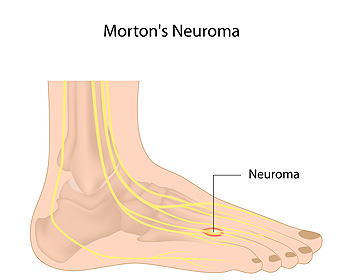Blog - Foot Doctor, Chambersburg and McConnellsburg, PA
Symptoms of a Broken Ankle
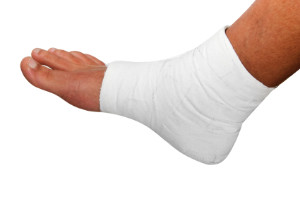 A broken ankle is often referred to as a fracture. There are several ways this can occur, including dropping a heavy object on your foot or twisting your ankle which commonly happens during a fall. Typical symptoms that can occur are bruising on and around your ankle, in addition to pain and swelling. It may be difficult to walk or stand and this may be an indication of a broken ankle. In severe fractures, you may hear a snapping sound or observe the bone protruding from the skin. A proper diagnosis is necessary to determine the severity of the fracture, and this is typically accomplished by having an X-ray performed. Treatment may include wearing a cast or a boot and may possibly be removed six to eight weeks later. It’s suggested that you consult with a podiatrist if you feel you have broken your ankle.
A broken ankle is often referred to as a fracture. There are several ways this can occur, including dropping a heavy object on your foot or twisting your ankle which commonly happens during a fall. Typical symptoms that can occur are bruising on and around your ankle, in addition to pain and swelling. It may be difficult to walk or stand and this may be an indication of a broken ankle. In severe fractures, you may hear a snapping sound or observe the bone protruding from the skin. A proper diagnosis is necessary to determine the severity of the fracture, and this is typically accomplished by having an X-ray performed. Treatment may include wearing a cast or a boot and may possibly be removed six to eight weeks later. It’s suggested that you consult with a podiatrist if you feel you have broken your ankle.
Broken ankles need immediate treatment. If you are seeking treatment, contact Dr. Steven Schwartz from Pennsylvania. Our doctor can provide the care you need to keep you pain-free and on your feet.
Broken Ankles
A broken ankle is experienced when a person fractures their tibia or fibula in the lower leg and ankle area. Both of these bones are attached at the bottom of the leg and combine to form what we know to be our ankle.
When a physician is referring to a break of the ankle, he or she is usually referring to a break in the area where the tibia and fibula are joined to create our ankle joint. Ankles are more prone to fractures because the ankle is an area that suffers a lot of pressure and stress. There are some obvious signs when a person experiences a fractured ankle, and the following symptoms may be present.
Symptoms of a Fractured Ankle
- Excessive pain when the area is touched or when any pressure is placed on the ankle
- Swelling around the area
- Bruising of the area
- Area appears to be deformed
If you suspect an ankle fracture, it is recommended to seek treatment as soon as possible. The sooner you have your podiatrist diagnose the fracture, the quicker you’ll be on the way towards recovery.
If you have any questions, please feel free to contact our offices located in Chambersburg, and Mcconnellsburg, PA . We offer the newest diagnostic and treatment technologies for all your foot care needs.
How to Choose Shoes That Fit Correctly
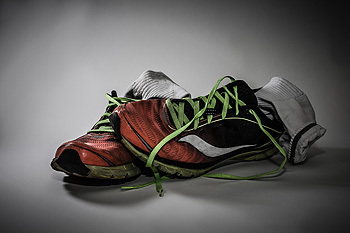 There are several foot conditions that may develop if the shoes that are chosen to be worn do not fit properly. Among these ailments are hammer toe, bunions, and ingrown toenails. The feet are considered to be the foundation of the body, and muscular imbalances may occur if shoes do not have a proper fit. When the shoes fit correctly, the foot will have adequate room to expand properly as the it connects with the ground. Research has shown that many runners purchase shoes that are too small. One of the reasons for this may be a lack of knowledge concerning the width of the toes. The foot is widest in the toe area, and many shoes do not have ample room in that part of the shoe. When purchasing shoes, it’s important to try shoes on both feet, because one foot is generally larger than the other. Wearing the types of socks that will be worn for the chosen activity and making sure there is enough room for the toes to move about will aid in choosing a correct fit.
There are several foot conditions that may develop if the shoes that are chosen to be worn do not fit properly. Among these ailments are hammer toe, bunions, and ingrown toenails. The feet are considered to be the foundation of the body, and muscular imbalances may occur if shoes do not have a proper fit. When the shoes fit correctly, the foot will have adequate room to expand properly as the it connects with the ground. Research has shown that many runners purchase shoes that are too small. One of the reasons for this may be a lack of knowledge concerning the width of the toes. The foot is widest in the toe area, and many shoes do not have ample room in that part of the shoe. When purchasing shoes, it’s important to try shoes on both feet, because one foot is generally larger than the other. Wearing the types of socks that will be worn for the chosen activity and making sure there is enough room for the toes to move about will aid in choosing a correct fit.
Finding a properly-fitting shoe is important in reducing injuries and preventing foot problems. For more information about treatment, contact Dr. Steven Schwartz from Pennsylvania. Our doctor will treat your foot and ankle needs.
Proper Shoe Fitting
A common concern when it comes to foot health, having properly fitted shoes can help prevent injuries to the foot. Out feet affect our posture and gait, which in turn affects the biomechanics and overall bodily structure. With 33 joints, 26 bones, and over 100 ligaments, the potential for serious injury is much greater than one realizes. Although the feet cease growth in adulthood, they still change shape as they mature. Here are some factors to consider when it comes to investing in proper fitting shoes:
- Be sure the shoes fit correctly right away
- Ensure the ball of your foot fits comfortably in the widest portion of the shoes
- Even though they may look fashionable, improper fitting shoes can either create adverse conditions or exacerbate existing ones you may already have
- Walk along a carpeted surface to ensure the shoes comfortably fit during normal activity
Keeping in mind how shoes fit the biomechanics of your body, properly-fitting shoes are vitally important. Fortunately, it is not difficult to acquire footwear that fits correctly. Be sure to wear shoes that support the overall structure of your body. Do your feet a favor and invest in several pairs of well-fitted shoes today.
If you have any questions please feel free to contact our offices located in Chambersburg, and Mcconnellsburg, PA . We offer the newest diagnostic and treatment technologies for all your foot and ankle needs.
What is Morton’s Neuroma?
There are several nerves that are located between the bones of the foot, and a condition referred to as Morton’s neuroma will typically affect the nerves between the third and fourth toes. Dr. Morton discovered this condition in 1876 and appropriately named the ailment Morton's Neuroma. It consists of the nerve between the toes becoming thickened, which may be the result of stress the foot has endured. Having sustained an injury to the foot may be a possible cause, in addition to wearing poorly fitting or extremely constrictive shoes, such as high heels. The symptoms can range from a dull ache between the toes to a tingling or burning feeling. To obtain moderate relief, it’s suggested to remove the shoe and gently massage the affected area. Treatment options may include wearing correct footwear which will allow adequate room for the toes to move about, in addition to using orthotics to alleviate some of the pain. Please consider scheduling a consultation with a podiatrist who can perform a correct diagnosis.
Morton’s neuroma is a very uncomfortable condition to live with. If you think you have Morton’s neuroma, contact Dr. Steven Schwartz of Pennsylvania. Our doctor will attend to all of your foot care needs and answer any of your related questions.
Morton’s Neuroma
Morton's neuroma is a painful foot condition that commonly affects the areas between the second and third or third and fourth toe, although other areas of the foot are also susceptible. Morton’s neuroma is caused by an inflamed nerve in the foot that is being squeezed and aggravated by surrounding bones.
What Increases the Chances of Having Morton’s Neuroma?
- Ill-fitting high heels or shoes that add pressure to the toe or foot
- Jogging, running or any sport that involves constant impact to the foot
- Flat feet, bunions, and any other foot deformities
Morton’s neuroma is a very treatable condition. Orthotics and shoe inserts can often be used to alleviate the pain on the forefront of the feet. In more severe cases, corticosteroids can also be prescribed. In order to figure out the best treatment for your neuroma, it’s recommended to seek the care of a podiatrist who can diagnose your condition and provide different treatment options.
If you have any questions, please feel free to contact our offices located in Chambersburg, and Mcconnellsburg, PA . We offer the newest diagnostic and treatment technologies for all your foot care needs.
Symptoms of an Achilles Tendon Injury
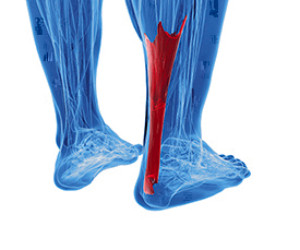 If you have severe pain in the back of your heel, you may have an Achilles tendon injury. It is the body’s thickest tendon, and it connects the back of the heel to the calf muscles. When the foot pushes forward while running, the Achilles tendon absorbs the force necessary for this to be accomplished. The beginning of an injury is typically represented by a dull ache in the back of the heel, and the pain will increase in severity if the running activity continues. There may be several causes for this type of injury to occur, including a poor range of motion in the ankle, calf muscles that are weakened, and having flat feet. Specific exercises that are practiced may aid in the healing of an Achilles tendon injury, and it’s recommended to see a podiatrist for a proper examination.
If you have severe pain in the back of your heel, you may have an Achilles tendon injury. It is the body’s thickest tendon, and it connects the back of the heel to the calf muscles. When the foot pushes forward while running, the Achilles tendon absorbs the force necessary for this to be accomplished. The beginning of an injury is typically represented by a dull ache in the back of the heel, and the pain will increase in severity if the running activity continues. There may be several causes for this type of injury to occur, including a poor range of motion in the ankle, calf muscles that are weakened, and having flat feet. Specific exercises that are practiced may aid in the healing of an Achilles tendon injury, and it’s recommended to see a podiatrist for a proper examination.
Achilles tendon injuries need immediate attention to avoid future complications. If you have any concerns, contact Dr. Steven Schwartz of Pennsylvania. Our doctor can provide the care you need to keep you pain-free and on your feet.
What Is the Achilles Tendon?
The Achilles tendon is a tendon that connects the lower leg muscles and calf to the heel of the foot. It is the strongest tendon in the human body and is essential for making movement possible. Because this tendon is such an integral part of the body, any injuries to it can create immense difficulties and should immediately be presented to a doctor.
What Are the Symptoms of an Achilles Tendon Injury?
There are various types of injuries that can affect the Achilles tendon. The two most common injuries are Achilles tendinitis and ruptures of the tendon.
Achilles Tendinitis Symptoms
- Inflammation
- Dull to severe pain
- Increased blood flow to the tendon
- Thickening of the tendon
Rupture Symptoms
- Extreme pain and swelling in the foot
- Total immobility
Treatment and Prevention
Achilles tendon injuries are diagnosed by a thorough physical evaluation, which can include an MRI. Treatment involves rest, physical therapy, and in some cases, surgery. However, various preventative measures can be taken to avoid these injuries, such as:
- Thorough stretching of the tendon before and after exercise
- Strengthening exercises like calf raises, squats, leg curls, leg extensions, leg raises, lunges, and leg presses
If you have any questions please feel free to contact our offices located in Chambersburg, and Mcconnellsburg, PA . We offer the newest diagnostic tools and technology to treat your foot and ankle needs.
Symptoms of Sesamoiditis
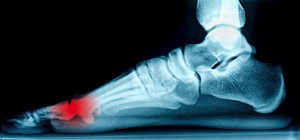 If you experience pain between the ball of the foot and the big toe, you may have a condition referred to as sesamoiditis. It originates from the sesamoid bones, which can be found under the big toe. If the foot has a high arch, these tiny bones endure additional pressure while walking or running. The purpose of the sesamoid bones is to propel the foot forward while walking, which may become difficult to accomplish if they become injured. The symptoms typically consist of pain in the foot while walking, in addition to becoming red and swollen. Wearing a shoe with adequate padding will aid in attaining a certain amount of relief and may take a portion of the pressure off the sesamoid bones. Additional treatment techniques may consist of binding the big toe, which may limit movement, and utilizing crutches to keep the weight off the foot. Please schedule a consultation with a podiatrist if you would like additional information about sesamoiditis.
If you experience pain between the ball of the foot and the big toe, you may have a condition referred to as sesamoiditis. It originates from the sesamoid bones, which can be found under the big toe. If the foot has a high arch, these tiny bones endure additional pressure while walking or running. The purpose of the sesamoid bones is to propel the foot forward while walking, which may become difficult to accomplish if they become injured. The symptoms typically consist of pain in the foot while walking, in addition to becoming red and swollen. Wearing a shoe with adequate padding will aid in attaining a certain amount of relief and may take a portion of the pressure off the sesamoid bones. Additional treatment techniques may consist of binding the big toe, which may limit movement, and utilizing crutches to keep the weight off the foot. Please schedule a consultation with a podiatrist if you would like additional information about sesamoiditis.
Sesamoiditis is an unpleasant foot condition characterized by pain in the balls of the feet. If you think you’re struggling with sesamoiditis, contact Dr. Steven Schwartz of Pennsylvania. Our doctor will treat your condition thoroughly and effectively.
Sesamoiditis
Sesamoiditis is a condition of the foot that affects the ball of the foot. It is more common in younger people than it is in older people. It can also occur with people who have begun a new exercise program, since their bodies are adjusting to the new physical regimen. Pain may also be caused by the inflammation of tendons surrounding the bones. It is important to seek treatment in its early stages because if you ignore the pain, this condition can lead to more serious problems such as severe irritation and bone fractures.
Causes of Sesamoiditis
- Sudden increase in activity
- Increase in physically strenuous movement without a proper warm up or build up
- Foot structure: those who have smaller, bonier feet or those with a high arch may be more susceptible
Treatment for sesamoiditis is non-invasive and simple. Doctors may recommend a strict rest period where the patient forgoes most physical activity. This will help give the patient time to heal their feet through limited activity. For serious cases, it is best to speak with your doctor to determine a treatment option that will help your specific needs.
If you have any questions please feel free to contact our offices located in Chambersburg, and Mcconnellsburg, PA . We offer the newest diagnostic and treatment technologies for all your foot and ankle needs.
Why Are My Feet Swollen During My Pregnancy?
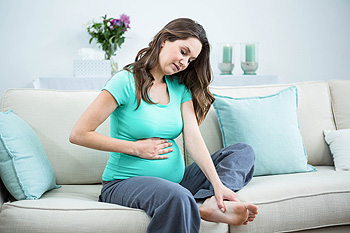 Pregnancy can create certain health conditions, and this may be apparent in the feet. Hormonal changes can be responsible for softening ligaments in the body, and the feet are often affected. Becoming flat-footed may be a result of these changes, in addition to shoes increasing in size. The feet must endure the additional weight that develops; any may contribute to the onset of heel pain. The feet may swell, which is a result of excess fluids in the body. This can possibly be managed by limiting the amount of time standing. Additionally, it is important to drink plenty of fresh water daily, and this will help to flush out some of the fluid that has accumulated in the feet. If heel pain due to pregnancy has affected your daily routine, please consider consulting with a podiatrist.
Pregnancy can create certain health conditions, and this may be apparent in the feet. Hormonal changes can be responsible for softening ligaments in the body, and the feet are often affected. Becoming flat-footed may be a result of these changes, in addition to shoes increasing in size. The feet must endure the additional weight that develops; any may contribute to the onset of heel pain. The feet may swell, which is a result of excess fluids in the body. This can possibly be managed by limiting the amount of time standing. Additionally, it is important to drink plenty of fresh water daily, and this will help to flush out some of the fluid that has accumulated in the feet. If heel pain due to pregnancy has affected your daily routine, please consider consulting with a podiatrist.
Pregnant women with swollen feet can be treated with a variety of different methods that are readily available. For more information about other cures for swollen feet during pregnancy, consult with Dr. Steven Schwartz from Pennsylvania. Our doctor will attend to all of your foot and ankle needs.
What Foot Problems Can Arise During Pregnancy?
One problem that can occur is overpronation, which occurs when the arch of the foot flattens and tends to roll inward. This can cause pain and discomfort in your heels while you’re walking or even just standing up, trying to support your baby.
Another problem is edema, or swelling in the extremities. This often affects the feet during pregnancy but tends to occur in the later stages.
How Can I Keep My Feet Healthy During Pregnancy?
- Wearing orthotics can provide extra support for the feet and help distribute weight evenly
- Minimize the amount of time spent walking barefoot
- Wear shoes with good arch support
- Wear shoes that allow for good circulation to the feet
- Elevate feet if you experience swelling
- Massage your feet
- Get regular, light exercise, such as walking, to promote blood circulation to the feet
If you have any questions please feel free to contact our offices located in Chambersburg, and Mcconnellsburg, PA . We offer the newest diagnostic and treatment technologies for all your foot and ankle needs.
What Are The Treatment Options for Bunions?
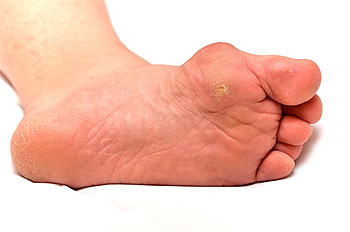 A bunion is often easily identified because of the large bony protrusion that appears on the side of the big toe.The skin on top of the bone may look red and and can become painful due to the friction the toes experience from shoes. Bunions can be caused by conditions such as arthritis or an abnormal foot structure that may possibly be inherited. The condition can also be made worse by wearing shoes that fit poorly. If you suffer from this ailment, it’s recommended to wear wider shoes to accommodate the affected toe. A more permanent solution would be surgery, in which the bunion is removed. If you have this condition, please consult with a podiatrist for additional information and to determine the best treatment option for you.
A bunion is often easily identified because of the large bony protrusion that appears on the side of the big toe.The skin on top of the bone may look red and and can become painful due to the friction the toes experience from shoes. Bunions can be caused by conditions such as arthritis or an abnormal foot structure that may possibly be inherited. The condition can also be made worse by wearing shoes that fit poorly. If you suffer from this ailment, it’s recommended to wear wider shoes to accommodate the affected toe. A more permanent solution would be surgery, in which the bunion is removed. If you have this condition, please consult with a podiatrist for additional information and to determine the best treatment option for you.
If you are suffering from bunions, contact Dr. Steven Schwartz of Pennsylvania. Our doctor can provide the care you need to keep you pain-free and on your feet.
What Is a Bunion?
A bunion is formed of swollen tissue or an enlargement of boney growth, usually located at the base joint of the toe that connects to the foot. The swelling occurs due to the bones in the big toe shifting inward, which impacts the other toes of the foot. This causes the area around the base of the big toe to become inflamed and painful.
Why Do Bunions Form?
Genetics – Susceptibility to bunions are often hereditary
Stress on the feet – Poorly fitted and uncomfortable footwear that places stress on feet, such as heels, can worsen existing bunions
How Are Bunions Diagnosed?
Doctors often perform two tests – blood tests and x-rays – when trying to diagnose bunions, especially in the early stages of development. Blood tests help determine if the foot pain is being caused by something else, such as arthritis, while x-rays provide a clear picture of your bone structure to your doctor.
How Are Bunions Treated?
- Refrain from wearing heels or similar shoes that cause discomfort
- Select wider shoes that can provide more comfort and reduce pain
- Anti-inflammatory and pain management drugs
- Orthotics or foot inserts
- Surgery
If you have any questions, please feel free to contact our offices located in Chambersburg, and Mcconnellsburg, PA . We offer the newest diagnostic and treatment technologies for all your foot care needs.
Causes of Running Injuries Involving the Feet
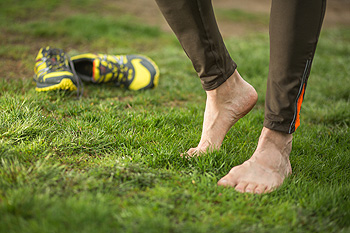 People who are serious about running know the importance of injury prevention. Most runners will experience sore feet, in addition to other ailments the feet may incur. The toenails may be affected from sneakers not fitting correctly or from wearing the wrong type of running shoes. A condition referred to as plantar fasciitis may develop, which often begins as heel pain. The plantar fascia is the ligament that connects the heel to the toes, and consistent running may stretch the ligament and surrounding tendons, possibly causing tearing. Blisters can frequently form, typically as a result of friction occurring because of poorly fitting sneakers. Several of these injuries can be prevented simply by choosing the correct shoes to wear while running. This process should consist of choosing shoes with adequate room for the toes to move around in and making sure there is enough support to accommodate the arches. It’s advised to consult with a podiatrist for additional information on how to prevent running injuries.
People who are serious about running know the importance of injury prevention. Most runners will experience sore feet, in addition to other ailments the feet may incur. The toenails may be affected from sneakers not fitting correctly or from wearing the wrong type of running shoes. A condition referred to as plantar fasciitis may develop, which often begins as heel pain. The plantar fascia is the ligament that connects the heel to the toes, and consistent running may stretch the ligament and surrounding tendons, possibly causing tearing. Blisters can frequently form, typically as a result of friction occurring because of poorly fitting sneakers. Several of these injuries can be prevented simply by choosing the correct shoes to wear while running. This process should consist of choosing shoes with adequate room for the toes to move around in and making sure there is enough support to accommodate the arches. It’s advised to consult with a podiatrist for additional information on how to prevent running injuries.
Exercising your feet regularly with the proper foot wear is a great way to prevent injuries. If you have any concerns about your feet, contact Dr. Steven Schwartz of Pennsylvania. Our doctor will treat your foot and ankle needs.
How to Prevent Running Injuries
Many common running injuries are caused by overuse and overtraining. When the back of the kneecap starts wearing out and starts causing pain in your knee, this is commonly referred to as runner’s knee. Runner’s knee is a decrease in strength in your quadriceps and can occur if you’re not wearing properly fitted or supporting shoes. To prevent runner’s knee, focusing on hip strengthening is a good idea, as well as strengthening your quads to keep the kneecaps aligned.
What Are Some Causes of Running Injuries?
- One cause of a common running injury is called iliotibial band syndrome.
- Plantar fasciitis is also another common injury.
- Stress fractures can occur from overtraining, lack of calcium, or even your running style.
Best Ways to Prevent Running Injuries
- Wear footwear that fits properly and suits your running needs.
- Running shoes are the only protective gear that runners have to safeguard them from injury.
- Make a training schedule. Adding strengthening exercises as well as regular stretching can help keep you strong and limber and can lessen the possibility of injuries.
- Stretching keeps muscles limber; this will help you gain better flexibility.
If you have any questions please feel free to contact our offices located in Chambersburg, and Mcconnellsburg, PA . We offer the newest diagnostic and treatment technologies for all your foot and ankle needs.
How High Heels Affect Runners’ Feet
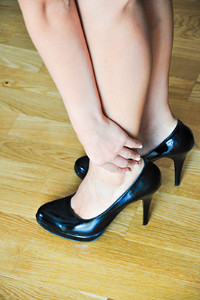 If you choose to wear high heels frequently, you may experience pain that’s common among those selecting to wear this type of shoe. Typically, when high heels are worn, the ankles bend forward, often affecting the circulation in the feet. Most runners are aware of how the arches are affected from wearing high heels and may experience aches and pains in the calves. There are several options available that may help the feet feel their best while running, one of which is limiting the time high heels are worn. It’s important to rest your feet between runs, and this is often accomplished by wearing supportive shoes. Performing proper exercises that stretch and strengthen the feet is beneficial in keeping the feet healthy and may allow the sport of running to be enjoyed to its full potential.
If you choose to wear high heels frequently, you may experience pain that’s common among those selecting to wear this type of shoe. Typically, when high heels are worn, the ankles bend forward, often affecting the circulation in the feet. Most runners are aware of how the arches are affected from wearing high heels and may experience aches and pains in the calves. There are several options available that may help the feet feel their best while running, one of which is limiting the time high heels are worn. It’s important to rest your feet between runs, and this is often accomplished by wearing supportive shoes. Performing proper exercises that stretch and strengthen the feet is beneficial in keeping the feet healthy and may allow the sport of running to be enjoyed to its full potential.
High heels have a history of causing foot and ankle problems. If you have any concerns about your feet or ankles, contact Dr. Steven Schwartz from Pennsylvania. Our doctor can provide the care you need to keep you pain-free and on your feet.
Effects of High Heels on the Feet
High heels are popular shoes among women because of their many styles and societal appeal. Despite this, high heels can still cause many health problems if worn too frequently.
Which Parts of My Body Will Be Affected by High Heels?
- Ankle Joints
- Achilles Tendon – May shorten and stiffen with prolonged wear
- Balls of the Feet
- Knees – Heels cause the knees to bend constantly, creating stress on them
- Back – They decrease the spine’s ability to absorb shock, which may lead to back pain. The vertebrae of the lower back may compress.
What Kinds of Foot Problems Can Develop from Wearing High Heels?
- Corns
- Calluses
- Hammertoe
- Bunions
- Morton’s Neuroma
- Plantar Fasciitis
How Can I Still Wear High Heels and Maintain Foot Health?
If you want to wear high heeled shoes, make sure that you are not wearing them every day, as this will help prevent long term physical problems. Try wearing thicker heels as opposed to stilettos to distribute weight more evenly across the feet. Always make sure you are wearing the proper shoes for the right occasion, such as sneakers for exercising. If you walk to work, try carrying your heels with you and changing into them once you arrive at work. Adding inserts to your heels can help cushion your feet and absorb shock. Full foot inserts or metatarsal pads are available.
If you have any questions please feel free to contact our offices located in Chambersburg, and Mcconnellsburg, PA . We offer the newest diagnostic and treatment technologies for all your foot and ankle needs.
What Children Need to Know About Athlete’s Foot
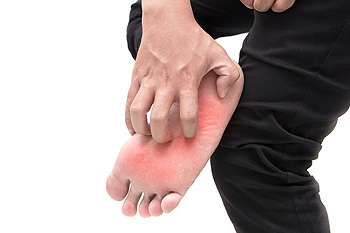 A fungus that lives on the toes and the bottom of feet is referred to as athlete’s foot. Public pools and showers are often a breeding ground for this type of fungus, and it may appear on your feet if you tend to walk barefoot in these areas. Parents may suggest wearing flip flops or shower shoes in public areas because they know the fungus can spread. There may be several signs you may notice that can indicate this condition is evident, including any blistered or cracked skin especially between the toes, severe itching, or a rash that appears on the inside of the foot. There are simple yet effective ways to prevent athlete’s foot from developing. Washing and drying the feet is important in keeping this ailment from spreading, and wearing proper footwear in public areas will decrease the chances of this condition from growing. If you have any symptoms relating to athletes foot, please ask your parents to schedule a consultation with a podiatrist for additional information.
A fungus that lives on the toes and the bottom of feet is referred to as athlete’s foot. Public pools and showers are often a breeding ground for this type of fungus, and it may appear on your feet if you tend to walk barefoot in these areas. Parents may suggest wearing flip flops or shower shoes in public areas because they know the fungus can spread. There may be several signs you may notice that can indicate this condition is evident, including any blistered or cracked skin especially between the toes, severe itching, or a rash that appears on the inside of the foot. There are simple yet effective ways to prevent athlete’s foot from developing. Washing and drying the feet is important in keeping this ailment from spreading, and wearing proper footwear in public areas will decrease the chances of this condition from growing. If you have any symptoms relating to athletes foot, please ask your parents to schedule a consultation with a podiatrist for additional information.
Athlete’s foot is an inconvenient condition that can be easily reduced with the proper treatment. If you have any concerns about your feet and ankles, contact Dr. Steven Schwartz from Pennsylvania. Our doctor will treat your foot and ankle needs.
Athlete’s Foot: The Sole Story
Athlete's foot, also known as tinea pedis, can be an extremely contagious foot infection. It is commonly contracted in public changing areas and bathrooms, dormitory style living quarters, around locker rooms and public swimming pools, or anywhere your feet often come into contact with other people.
Solutions to Combat Athlete’s Foot
- Hydrate your feet by using lotion
- Exfoliate
- Buff off nails
- Use of anti-fungal products
- Examine your feet and visit your doctor if any suspicious blisters or cuts develop
Athlete’s foot can cause many irritating symptoms such as dry and flaking skin, itching, and redness. Some more severe symptoms can include bleeding and cracked skin, intense itching and burning, and even pain when walking. In the worst cases, Athlete’s foot can cause blistering as well. Speak to your podiatrist for a better understanding of the different causes of Athlete’s foot, as well as help in determining which treatment options are best for you.
If you have any questions please feel free to contact our offices located in Chambersburg, and Mcconnellsburg, PA . We offer the newest diagnostic and treatment technologies for all your foot and ankle needs.

